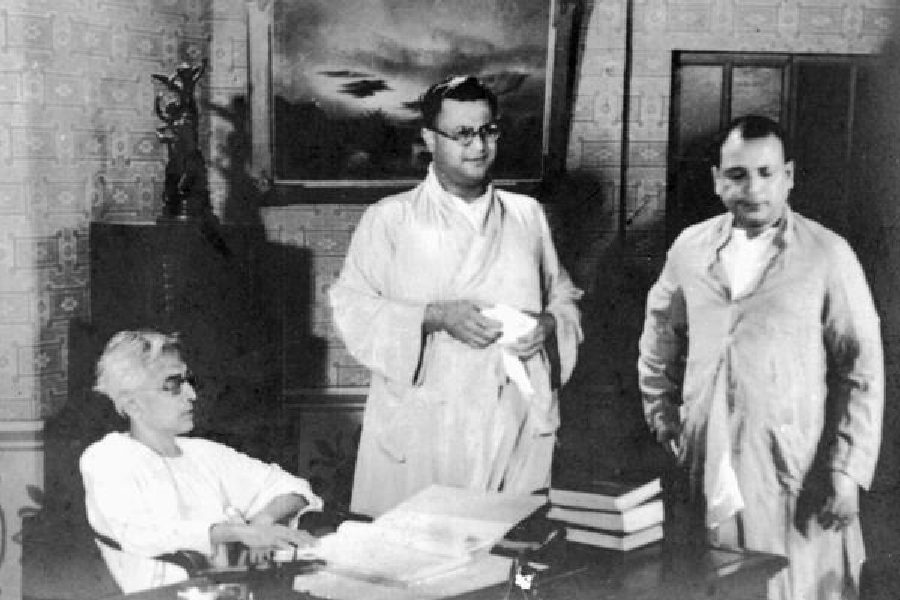Awestruck, I enter the hallowed precincts of New Theatres in Tollygunge, set up in 1930 by B.N. Sircar, a qualified civil engineer.
I can’t take my eyes off the tall, barn-like structures where iconic films such as Devdas, Chandidas, Desher Maati and Udayer Pathe were filmed by directors like Pramathesh Baruah, Debaki Bose, Nitin Bose and Bimal Roy. Today the sooty-grey buildings are buzzing with shoots of television serials. The sprawling floors, where Kundan Lal Saigal, Kanan Devi and Basanta Choudhury faced the cameras for black-and-white classics of the early “talkie” era, are currently divided into several sets, where domestic soap operas are playing out.
A nursery of Bengali cinema, New Theatres had many firsts to its credit. One of the first Bengali talkies, the Premankur Atarthy directed Dena Paona was produced here in 1931 — the same year that Alam Ara, credited in cinematic history as the first talkie in India, was released.
Nitin Bose was the first to introduce playback singing in 1935 with Bhagya Chakra (the Hindi version was Dhoop Chhaon). He also lugged heavy cameras outdoors to shoot films like Desher Maati (1938) when outdoor shoots were rare.
With Sircar providing them unstinting support, the directors of New Theatres brought alive many a literary masterpiece in cinematic form. The very air of the studio seemed suffused with creativity. Nitin Bose would, apparently, narrate entire scripts to his assistants under the shade of the bakul trees.
Technically, too, the studio was always at the forefront. Sircar had the knack of spotting talent and grooming them into outstanding artistes. K.L. Saigal and Kanan Devi soared to unprecedented heights, as singer-actors, working in his productions. Decades later, the working environment has changed. A slim beauty, in a blue, nylon sari, breezes past me to mouth her lines, in sync, in air-conditioned environs, for a television episode that will be seen in mansions and hovels alike.
My mind flashes back to a black-and-white scene from Mukti (1937), where a lovelorn Kanan Devi, all lace and frills, appeals to her nonconformist, artist husband to heed her rich father’s advice. How she managed to look so ethereal in a non-air-conditioned studio was a miracle.
In its heyday, New Theatres produced one gem after another, which ticket-paying audiences lapped up, as much for their stories, poignant dialogues and music as they did for the actors.
Alas, the turmoil of Partition halved the market for Bengali films, even as spectacular films from Bombay and Madras provided stiff competition. Slowly but surely, New Theatres went into economic decline and finally, in the 1950s, Sircar had to
call it a day.
New Theatres today is a private limited company but, financially, the going
is still tough. Being let out for shoots to other producers may have given a new lease of life to the historic institution, but it is still an uphill task keeping up with the times.
Saugata Nandi, a director of the company, says, “We are gasping for breath.” Providing modern facilities and maintaining nearly 100-year-old structures that were not designed for today’s filmmaking style is expensive. “I don’t know how long we will be able to continue,” says Nandi, even as he hopes to set up a museum showcasing the studio’s illustrious past, and state-of-the-art facilities, as part of New Theatres’ centenary celebrations in 2030.
Shree Bharat Lakshmi Pictures was set up in 1934, also with the most advanced technological facilities of the time, by a passionate lover of cinema, Babulal Choukhani. This studio, too, is surviving thanks mainly to television. Two of my favourite serials are being shot here when I visit the studio within whose walls lie stories of a glorious past. Currently, one of the floors has a smart kitchen, a grand drawing room and a beautifully-styled staircase while another floor has a more modest interior suitable for another serial. The spaces outside also show signs of shoots — a fisherman’s village and a street with election banners.
I am privileged to enter a room where there is a vintage camera, an organ which S.D. Burman played and posters of films from a bygone era — precious memorabilia harking back to times when a non-Bengali produced entertainers such as Alibaba, Pratikar, Matir Ghar and many more. At one time, this was an editing room.
Interestingly, a bunch of keys kept here were instrumental in making Babulal’s grandson, 18-year-old Jyoti, revive the studio after three decades. When Babulal stopped making films in the 1960s, the floors were let out to petty manufacturers, who put new locks to their workshops. The sight of Babulal’s keys lying unused dejected Jyoti immensely; and one day he decided to turn back the hands of the clock. With generous compensation to the tenants, he gently persuaded them to vacate the premises; and restored the studio to its original form. “The thrill I get opening the locks of the studio with keys that belong to our family is inexplicable,” he exclaims. With justifiable pride, he points out that their studio has always been in the possession of the Choukhani family, ups and downs notwithstanding.
Keeping studios afloat is a marathon task, financially and otherwise. In Mumbai, most of the iconic ones have been pulled down and replaced with commercial and residential “towers”. Thankfully, New Theatres and Shree Bharat Lakshmi Pictures have come out of the doldrums and are resonating again with intonation of — Silence, Sound, Action.











